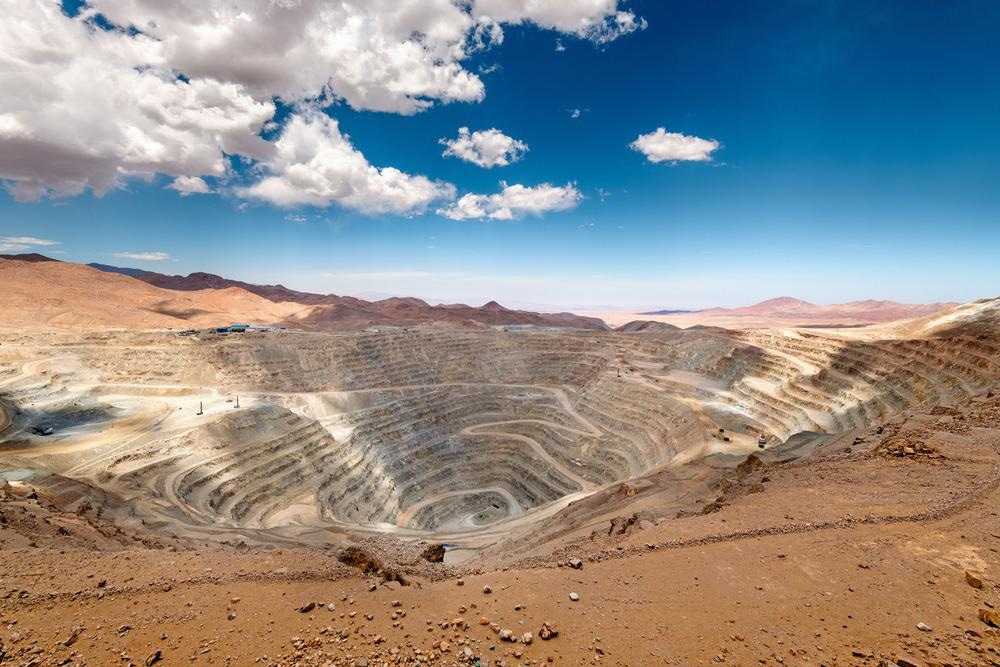From smartphones to cars, many of our modern materials are made with raw materials from the ground. Technologies continue to advance and more green infrastructure is being produced such as electric vehicles and wind turbines. All need minerals like nickel, manganese, copper, uranium, and rare earth elements. As mining demands are increasing, we must efficiently find sources of essential minerals and metals by testing rock and mineral properties.

Image Credit: Jose Luis Stephens/Shutterstock.com
The early stages of mining begin with searching an area via hand samples on the ground surface or drilling to take samples underground, where rock properties can then be tested. You can even begin to test rock properties right away as soon as you hold a rock in your hand. For example, you could test the hardness of minerals in the rock by trying to scratch the mineral against a steel knife, if it doesn’t scratch, you can tell it is softer than quartz, which has a 7 rating on the Mohs hardness scale: considered to be one of the most valuable methods for identifying minerals in the field. Friedrich Mohs, a German mineralogist, produced the scale, whereby any higher number mineral will scratch any mineral with a lower number.
An acidity test can be carried out by applying vinegar to the rock and seeing if it fizzes. Of particular interest to miners is the presence of metals in rocks. For detection, you could do a magnetism test to see any metal minerals, by holding a magnet near the rock, and feeling if there is a magnetic pull. Most minerals can be characterized and classified by their unique physical properties, including their hardness, color, fracture, streak (propensity to cause a streak after rubbing on paper), luster (the way light interacts on the surface), and tenacity (how well a mineral resists breakage).
Core Samples are ‘At the Core’ of Mineral Exploration
There are many more tests that geologists do to determine rock and mineral properties, the most sophisticated of which are in the laboratory. Rock samples from cores drilled from the ground are sent to these laboratories for comprehensive tests.
Core sampling is essential for finding underground resources. Many layers of rocks dating across millions of years can be unearthed to help scientists understand what has happened and where minerals might have formed. By identifying a prosperous layer, the geological horizon can be traced in the surrounding landscape, so miners know where to apply their more extensive mining operations.
A core sample extending in the tens or thousands of meters may be taken after drilling. The semi-cylindrical column of subsurface rock is removed and examined in the laboratory where there is diverse equipment available: from light microscopy, scanning electron microscopy, X-ray powder diffraction (XRD) to X-ray fluorescence (XRF) equipment that reveals the mineralogical and chemical make-up of rocks.
Through these techniques, small signs of copper or nickel could be the clue needed to have the confidence to go ahead with mining a location in a certain way, which comes with a financial gamble. Each detail within the rock properties of a core sample helps pin-point exactly where companies should mine, and reduces the risk of investing big budgets in what could turn out to be a dry prospect.
Core sampling is a technique that has been used in both mining and the subsea exploration of hydrocarbons for decades. Even on Mars, core samples are now being taken, and transported back to Earth to be analyzed.
Core Sample Testing in the Mining Industry
Many companies provide core sample testing services. At Intertek, services are extensive, including precious metal analysis, mineral sample preparation procedures, core cutting, particle size analysis, and precious metals analysis through fire assay or cyanide leach techniques. Geoscientists may also do geochemical analysis to find gold and multi-elements by Squa Regia Digestion, or trace elements by XRF.
Demand for Nickel to Rise
One of the key mineral resources expected to be a big part of the future is nickel – a “hidden mineral” all around us, even in our cutlery and computers. In the US, Eagle Mine provides 1.5% of the world’s nickel, but demand is set to increase with the rise of the green transition for use in electric car batteries, wind turbines, and more.
In the UK, Glencore is one of the four most prominent mining companies in the country, with operations also in Canada, Europe, Australia, New Caledonia, and in the South Pacific. The company produces some of the highest quality nickel in the market.
Trevor Blair - Senior Supervisor, Strategic Planning & Business Development at Raglan Mine said in a press release, “The future of nickel is bright. I see it as an element of change not only to build emerging economies, assets and infrastructure, but also to be able to connect the world.”
As mining operations continue and expand in response to a growing global need for certain metals and minerals, careful geological analysis of rock properties in the field and the laboratory will be more important than ever to improve mining operations, cut costs and boost the chances of success.
References and Further Reading
X-Ray Powder Diffraction. USGS. Available at: https://pubs.usgs.gov/info/diffraction/html/ (Accessed 29 April 2022.)
X-Ray Fluorescence (XRF). Geochemical Instrumentation and Analysis. Available at: https://serc.carleton.edu/research_education/geochemsheets/techniques/XRF.html (Accessed 29 April 2022.)
The Journey of Nickel. Glen Core. Available at: https://www.glencore.com/what-we-do/metals-and-minerals/nickel/the-journey-of-nickel?item=investing (Accessed 29 April 2022.)
Using characteristics of minerals to identify them. Illinois State Geological Survey. Available at: https://illinois.edu/ (Accessed 29 April 2022.)
Authier, André (2013). Early Days of X-ray Crystallography. Oxford University Press. ISBN 978-0-19-965984-5.
Disclaimer: The views expressed here are those of the author expressed in their private capacity and do not necessarily represent the views of AZoM.com Limited T/A AZoNetwork the owner and operator of this website. This disclaimer forms part of the Terms and conditions of use of this website.